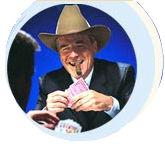The number of video gambling machines in Montana declined slightly between
2004 and June 30, 2006, but gamblers were putting more money in the machines
that remained. Statistics compiled by the Gambling Control Division of the
Department of Justice show that the total number of establishments with
video gambling statewide increased by just one between ’04 and the end of
fiscal year ’06, from 1,727 to 1,728. During the same period, the total
number of video gambling machines actually declined, from 17,239 to 16,498.
While those numbers crept downward, the amount of money fed into the
machines continued to rise. According to the Justice Department’s Gambling
Control Division, Montanans wagered a record $1.13 billion on video gambling
machines in fiscal year 2006, which ended June 30. The amount wagered this
year was up from $1.06 billion in 2005 and $1.01 billion in 2004. In
Yellowstone County as of June 30, there were 134 businesses offering
gambling in Billings, 10 in Laurel, two in Broadview and 28 elsewhere in the
county. The figures for Billings include everything within a five-mile
radius of city limits. The number of machines in the county increased from
2,374 in ’04 to 2,397 this year. Small fluctuations across the state led to
the increase of one gambling establishment from 2004 to 2006. For instance,
the number of establishments with video gambling machines increased from 107
to 110 in Butte-Silver Bow County, while the number in Cascade County
dropped from 152 to 149. Missoula County lost two, dropping to 128 in ’06,
while Gallatin County gained three, going to 97. In all of Treasure County
in 2004, there was just one bar with two machines. Both numbers doubled in
2006, to two bars with four gambling machines. That tied the county with
Petroleum County, which also had two bars and four machines, down from two
bars and five machines in 2004.
Despite the decline in the number of machines in Montana, the amount of
money spent on gambling increased this year. Gambling tax collections – from
a 15 percent tax on gross gambling machine income – totaled just under $57
million in fiscal year 2006, up from a little over $53 million in 2005. All
that money goes into the state general fund. In 1990, the gambling tax
raised just $17 million. Tax revenues jumped to $31.3 million by 1995, and
to $41.5 million in 2001. From 1994 to last June, the state collected a
total of $585.2 million in gambling machine taxes.
The figures showing a reduction in the number of machines statewide can be a
little misleading. Video gambling machines originally offered just one game,
poker or keno, on a single machine, and for a time a bar or casino could
only have 10 poker machines and 10 keno machines. Now bars and casinos can
have up to 20 machines with any combination of games, and one machine can
have a mix of poker and keno, with some machines offering 25 different
games.
John Blair, owner of the Reno Club on Calhoun Lane and a former chairman of
the state Gaming Advisory Council, called the new machines “the same old
whore in a new kimono.” Even so, he said, they do seem to have contributed
to the uptick in gambling.
“I think maybe gambling’s on the rise, maybe because of the bells and
whistles,” he said.
The newest bells and whistles are on the U1 machine, manufactured by a
company in Belgrade and being distributed by Century Gaming, the largest
owner and distributor of video gaming machines in Montana. Steve Arntzen, a
co-owner and chief operating officer of Century Gaming, said the company
traditionally has distributed machines it owns.
But in this case, the company in Belgrade wanted to test out the new U1
machine here before placing them in casinos the company owns in Nevada, and
Century Gaming agreed, for a price, to put them in casinos to which it
already supplies machines. The U1 machines have a 24-inch-wide,
ultra-high-definition screen and a special chair that can be ergonomically
adjusted, as can the screen itself. Arntzen said the difference between the
U1 machines and traditional games is like the difference between
PlayStations 2 and 3.
Spending on other forms of gaming in Montana hardly begins to compare with
the spending on video gambling.
In comparison with the $1.13 billion wagered on gambling machines in 2006,
the next biggest amount wagered was on the lottery, on which Montanans spent
$39.9 million. That was followed by simulcast racing, $7 million; live
bingo, $3.5 million; live keno, $3.1 million; and live horse racing, $1.9
million.
Except for the lottery and gambling machines – and live horse racing, which
stayed the same – amounts wagered in 2006 were down compared to 2005.
The state doesn’t track how much is wagered on live poker games, which saw a
surge in recent years, but the trend there seems to be running downhill.
Card dealer licenses issued soared from 157 in 2004 to 582 in 2005, but it
dropped down to 450 in 2006.
